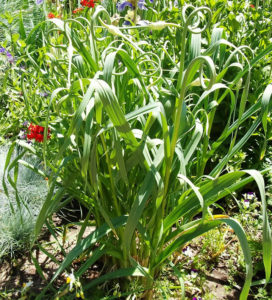 If you like garlic, now’s the time to plant some in your garden. You’ll thank yourself next summer when you dig up beautiful heads of flavorful garlic.
If you like garlic, now’s the time to plant some in your garden. You’ll thank yourself next summer when you dig up beautiful heads of flavorful garlic.
Garlic is actually an herb that’s a member of the lily family. It may have originated in Central Asia, but it’s so adaptable it can grow just about anywhere.
There are just a few gardening ideas to keep in mind when planting garlic. First, choose the freshest seed garlic you can find at the garden center. Look for large firm and unblemished bulbs without any obvious problems. One pound of seed garlic will yield between 8-10 pounds of harvested garlic.
Second, choose varieties based on how you plan to use your homegrown garlic. Choose from hardneck or softneck varieties.
Hardneck garlic varieties are popular for their flavor, are easier to peel and can be stored for up to 6 months. Hardneck varieties produce a flower stalk called a scape, which can also be used in cooking.
Softneck varieties are the same kind of garlic found in grocery stores. Softneck varieties are usually more productive than hardneck garlic and can be stored for up to a year. Because they’re good for storing, softneck garlic types are often used for braiding. Another difference is softneck varieties don’t produce a flower stalk.
Locate your garlic bed in a sunny spot in the garden that has fluffy, fertile, and well-drained soil. The night before you plant your garlic, separate the cloves from each bulb and soak in Liquid Kelp to give the cloves a good start. Don’t let cloves dry out.
Plant only the largest cloves for the biggest heads of garlic. Place the pointy end up, 1-2 inches below the surface of the soil and about 3-4 inches apart. Cover with about 2 inches of soil, water in deeply and add a thick layer of organic mulch. Straw, chopped leaves or dry, untreated grass clippings will help retain soil moisture.
Keep an eye on your garlic bed over winter and water if the soil is dry and daytime temperatures warm above 40 degrees.
In spring, once the danger of frost has passed, remove the thick mulch from the garlic bed and water deeply. Be sure to keep up with watering so soil stays moist and the garlic doesn’t have a chance to dry out.
Feed the garlic crop with either a composted manure or a well-balanced fertilizer as bulbs begin to grow. Be sure to keep the garlic bed weeded to avoid competition for space and nutrients.
If you planted hardneck garlic, watch for the tall flower stalks called scapes to emerge and cut them while they’re still young and tender (be sure to use the tender scapes in cooking). A good garlic gardening tip is to leave one scape standing. When the curly part starts to unfurl, your garlic is ready to harvest.
Another way to tell if garlic is ready to harvest is to watch for the green leaves to turn yellow. Stop watering and wait for the bottom leaves to turn brown. Use a garden fork to carefully lift the entire plant from the soil. Be careful and don’t damage the soft bulbs during harvest.
Place the fresh garlic in the shade to dry or cure for long-term storage. Once cured, store garlic bulbs in a mesh bag to allow for air circulation.
Then use your fresh garlic to flavor all your favorite savory dishes. And get ready to plant another crop next fall.


